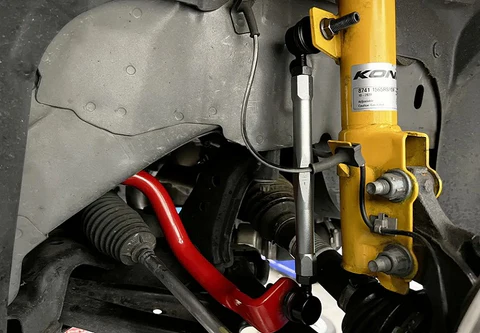Can Power Steering Fluid Be Mixed? Avoid Costly Errors!
No, power steering fluid should not be mixed. It can cause damage to the steering system.
Mixing power steering fluid can lead to reduced performance and potential mechanical issues. It is important to use the specific type of power steering fluid recommended for your vehicle to ensure proper function and avoid damage to the system. When it comes to maintaining your vehicle, it’s essential to understand the specifics of each fluid and component.
Power steering fluid is a crucial element in ensuring smooth and effortless steering operation. Mixing different types of power steering fluid can lead to inadequate lubrication and potential damage to the steering system. In this blog post, we will explore the importance of using the correct power steering fluid and the potential consequences of mixing different types. Additionally, we will provide guidance on how to properly maintain your power steering system to ensure optimal performance and longevity.
Can Power Steering Fluids Be Mixed? Avoid Costly Errors?
Using the wrong power steering fluid can lead to several issues in your vehicle’s power steering system. Different fluids have specific additives and viscosities designed for particular systems.
Using an incorrect fluid can cause:
- Poor Steering Performance: The steering may become harder or less responsive.
- System Damage: Incompatible fluids can cause seals and hoses to degrade or leak, leading to expensive repairs.
- Noise and Vibration: The wrong fluid can lead to unusual noises and vibrations while steering.
- Potential Failure: Over time, using the wrong fluid can cause the entire power steering system to fail.
Always use the fluid specified in your vehicle’s owner manual to ensure proper functioning and longevity of your power steering system. If you have used the wrong fluid, it’s advisable to flush the system and replace it with the correct fluid as soon as possible.
Introduction To Power Steering Fluid

Mixing power steering fluid can cause damage to the system. Always use the recommended fluid for optimal performance.
The Role Of Power Steering Fluid
Power steering fluid plays a critical role in ensuring smooth steering operation.
It provides hydraulic assistance to make steering easier for the driver.
Types Of Power Steering Fluids
There are two main types of power steering fluids: regular and synthetic.
Regular power steering fluid is petroleum-based, while synthetic is man-made.
Risks Of Mixing Different Fluids
Mixing different fluids can lead to damage in the power steering system. Power steering fluid should never be mixed as it can cause leaks and compromise performance. It’s crucial to always use the recommended fluid for your vehicle to avoid costly repairs.
Chemical Incompatibility Concerns
When it comes to power steering fluid, mixing different types of fluids can have severe consequences. Mixing fluids with different chemical compositions can result in chemical incompatibility. The chemical components of different fluids can react with each other and produce harmful substances that can damage the power steering system.
For example, some fluids contain different additives that can react with other fluids and cause clogs and corrosion. This can lead to steering failure, which can be dangerous while driving.
Impact On Steering Performance
Another risk of mixing power steering fluids is the impact it can have on steering performance. Different fluids have different viscosity levels, which can impact the power steering system’s operation. The viscosity level of the fluid determines how easily it flows through the system and how well it lubricates the system’s components.
When different fluids are mixed, the viscosity level can change, causing the power steering system to malfunction. The steering wheel may become difficult to turn or feel loose and unstable. This can result in a loss of control of the vehicle and put the driver and passengers at risk of an accident.
It is essential to use the correct power steering fluid specified by the manufacturer to avoid these risks. Mixing different fluids can have severe consequences and put the driver and passengers’ safety at risk. If you are unsure about the type of fluid to use, consult the vehicle owner’s manual or a professional mechanic.
Manufacturer Specifications
It is crucial to adhere to the manufacturer’s specifications when it comes to power steering fluid. Using the right type and maintaining the correct levels ensures optimal performance and longevity of the power steering system.
Importance Of Following Guidelines
Strictly adhering to the manufacturer’s guidelines for power steering fluid is vital. Neglecting this can lead to impaired steering performance, potential damage to the power steering pump, and other critical components of the system.
Differences Across Car Models
The type of power steering fluid required can vary between different car models. It’s essential to consult the owner’s manual or contact the manufacturer to ensure the correct fluid is used for a specific vehicle.
Identifying Your Steering Fluid Type
When it comes to maintaining your vehicle’s power steering system, one important aspect is identifying the type of power steering fluid your car requires. Using the wrong type of fluid can lead to potential damage to the system and affect the overall performance of your vehicle. In this section, we will explore the different methods you can use to identify your steering fluid type.
Checking The Owner’s Manual
The first and most reliable method to determine the type of power steering fluid your vehicle needs is by referring to the owner’s manual. The owner’s manual provides detailed information about the specifications and requirements of your car, including the recommended type of steering fluid. Look for the section on fluids or maintenance, and you should find the specific type of power steering fluid mentioned there.
Visual Inspection Tips
If you don’t have access to the owner’s manual or are unsure about its recommendations, you can visually inspect the power steering fluid to get an idea of its type. Here are some visual inspection tips:
- Locate the power steering fluid reservoir under the hood of your car. It is usually located near the engine and has a cap labeled “Power Steering.”
- Open the reservoir cap and observe the color and consistency of the fluid. Power steering fluid can be either clear or amber in color. If the fluid appears dark, brown, or black, it may indicate contamination and the need for a fluid flush.
- Pay attention to the smell of the fluid. Power steering fluid typically has a distinct odor, similar to burnt oil. If you notice a foul or unusual smell, it could indicate a problem with the fluid.
- Check the fluid level. The reservoir should have markers indicating the minimum and maximum levels. Ensure the fluid level is within the recommended range. Low fluid levels can indicate a leak in the system.
By visually inspecting the power steering fluid, you can get a general idea of its condition and determine if it needs to be replaced or topped up. However, it’s important to note that visual inspection alone may not provide you with the exact specifications of the fluid required for your vehicle. For accurate information, always refer to the owner’s manual or consult a professional mechanic.
Consequences Of Incorrect Fluid Mixing
Mixing the wrong power steering fluids can lead to serious consequences for your vehicle. Different fluids have varying compositions, and mixing them can result in reduced performance, leaks, or damage to the power steering system. It’s crucial to use the correct fluid specified by your vehicle’s manufacturer to ensure optimal functioning and prevent potential issues.
Damage To Power Steering System
When power steering fluid is mixed incorrectly, it can lead to severe damage to the power steering system of your vehicle. The power steering system relies on the proper viscosity and composition of the fluid to function efficiently. Mixing different types or brands of power steering fluid can result in a variety of problems that can compromise the performance and longevity of the system.
One of the potential consequences of using the wrong power steering fluid is the formation of foam. Foam can develop when incompatible fluids are mixed, causing air bubbles to be introduced into the system. These air bubbles can disrupt the smooth flow of fluid, leading to reduced power steering assistance and increased strain on the system components.
In addition to foam formation, mixing incorrect power steering fluids can also result in fluid breakdown. Different fluids may have different chemical compositions and additives, and when they are mixed, they can react negatively with each other. This can cause the fluid to degrade, losing its lubricating properties and potentially leading to increased wear and tear on the power steering pump, rack, and other components.
The power steering pump itself can also be adversely affected by incorrect fluid mixing. The pump is designed to operate with a specific type of fluid, and using the wrong one can put excessive strain on the pump’s internal components. Over time, this can lead to premature wear and eventual failure of the pump, resulting in expensive repairs.
Long-term Vehicle Impairments
The consequences of incorrect power steering fluid mixing can extend beyond immediate damage to the power steering system. Over the long term, using the wrong fluid can have lasting effects on your vehicle’s overall performance and reliability.
One potential long-term impairment is the degradation of seals and hoses within the power steering system. Different fluids may contain additives or chemicals that can cause these rubber components to deteriorate faster than they would with the correct fluid. As a result, leaks can develop, leading to a loss of power steering fluid and potential damage to other engine components.
In some cases, using the wrong power steering fluid can also void the manufacturer’s warranty. Automakers specify the type of fluid that should be used in their vehicles to ensure optimal performance and longevity. If you mix incompatible fluids and encounter power steering issues, the manufacturer may refuse to cover any repairs under warranty, leaving you responsible for the costs.
It is essential to consult your vehicle’s owner’s manual or contact a professional mechanic to determine the correct power steering fluid for your specific vehicle. By using the right fluid and avoiding mixing incompatible fluids, you can help prevent damage to your power steering system and ensure your vehicle remains in good working order for years to come.
Correcting Mixing Mistakes
Mixing power steering fluid can lead to problems with your vehicle’s steering system. It is important to avoid mixing different types of power steering fluid, as this can cause damage and compromise the effectiveness of the fluid. Always consult your vehicle’s manual and use the recommended type of power steering fluid to ensure optimal performance and prevent mixing mistakes.
Flush And Replace Procedure
When power steering fluid is mixed, it can lead to serious problems. To correct mixing mistakes, the flush and replace procedure is essential. This involves draining the contaminated fluid and replacing it with the correct type.
When To Seek Professional Help
If you are uncertain about the correct type of fluid or the flushing process, it’s crucial to seek professional help. Professional mechanics have the expertise and tools to resolve mixing errors effectively.
In the event of power steering fluid being mixed, the following steps should be taken to correct the mixing mistake:
1. Identify the Contaminant: Determine the type of fluid that was mistakenly added to the power steering system.
2. Drain the System: Remove the contaminated fluid completely from the power steering reservoir.
3. Refill with Correct Fluid: Add the appropriate type of power steering fluid as specified in the vehicle’s manual.
4. Bleed the System: Eliminate air from the system by turning the steering wheel from lock to lock.
It’s important to note that if you encounter any difficulties during this process, or if you are unsure about the type of fluid that was mixed, it is best to consult a professional mechanic for assistance.
Preventive Measures For Future Maintenance
Power steering fluid should not be mixed as it can lead to damage and malfunction of the power steering system. Preventive measures should be taken to ensure that only the recommended fluid is used for maintenance, avoiding any potential problems in the future.
Proper Fluid Storage And Handling
Store power steering fluid in a cool, dry place.
Keep the fluid container tightly sealed to prevent contamination.
Avoid mixing different types of power steering fluid.
Routine Power Steering Check-ups
Regularly inspect power steering fluid levels.
Look for any signs of leaks or fluid discoloration.
Check power steering system for any unusual noises or stiffness.
Expert Insights On Power Steering Maintenance
Gain expert insights on power steering maintenance regarding the critical question: can power steering fluid be mixed? Understand the potential risks and complications involved in mixing power steering fluid, and learn the best practices for maintaining a healthy power steering system.
Mechanic’s Advice On Fluid Care
Consult a mechanic for regular power steering fluid checks.
Faqs On Power Steering Fluids
Read on for answers to common questions about power steering fluid.
Expert Insights on Power Steering Maintenance:
Maintaining your power steering system is crucial for optimal performance.
Regularly check power steering fluid levels to prevent issues.
Consult a mechanic if you notice any leaks or unusual noises.
Conclusion
Mixing power steering fluid is not recommended as it can cause damage to the system. It is important to always use the recommended type of fluid for your vehicle and to regularly check the fluid levels. Neglecting to do so can lead to costly repairs and potentially dangerous driving situations.
By following the manufacturer’s guidelines and seeking professional advice when needed, you can ensure the longevity and safety of your vehicle’s power steering system.

Specializes on car underchassis & power steering repair. We have experienced mechanic to attend all your underchassis & power steering repair needs.



